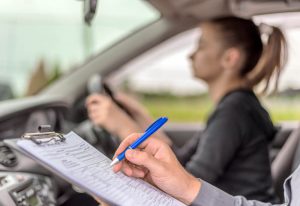Hazard Perception Test Tips: Everything You Need to Know
More help for you
- How the hazard perception test works
- Explanatory video
- Summary of the format
- Sample hazard perception test videos
- 8 examples of developing hazards
- How can you practise hazard perception questions?
Unfortunately for learner drivers these days, the multiple-choice questions answered in a theory test are only half the battle.
That’s because it is quickly followed by the hazard perception exam -- a series of 14 questions which carry a total of 75 marks. Doing well here is crucial if you’re going to walk out of the test centre with a theory certificate. You need 44 marks to pass.
Need to practise instead of reading about it? Take a free practice test here: Hazard Perception Test.
Here, we’ve brought together key facts about the format of the test, the dos and don’ts of using the video-based system, and some useful examples of the “developing hazards” you’ll be tasked with detecting.
Here are the 5 top hazard perception test tips:
- Know what to expect -- practice the test first. There are several online practice hazard perception tests so do a few to be prepared.
- Don’t click too much. Click the mouse or touch the screen as soon as the hazard emerges.
- Don’t wait too long. Click as soon as you notice a potential hazard -- it’s likely that it’ll turn into a developing hazard.
- Know the 8 examples of developing targets (see below).
- Remember that no points are lost if you get a question wrong.
How the hazard perception test works
Once you have answered the 50 questions in the multiple-choice section, you are entitled to a three-minute break before embarking on the hazard perception test. It’s worth seizing this opportunity, as you’re going to be watching a series of videos filmed from the vantage point of a driving seat. The objective is simple: click as soon as you see a potential danger emerging. The short video clips you will see in the hazard perception test will contain both developing and potential hazards. A potential hazard is something you need to be aware of but does not require you to take any action. A developing hazard is a thing that would make you take some kind of action, for example slowing down, stopping or changing direction.
There’s an explanatory video (below) with helpful commentary over example footage before the questions begin. If you’re not fully clear on everything, it is possible to watch this clip twice.
Here’s a summary of the format:
- You are going to be shown 14 clips, each lasting 60 seconds
- 13 clips contain one developing hazard, while one clip will contain two developing hazards
- You need to tap the touch screen or click the mouse (depending on the test centre) as soon as you see a developing hazard. This could involve other vehicles, pedestrians or poor road conditions
- You only get one chance at each question, with no retakes. To get full marks, you need to click the mouse or touch the screen as soon as the hazard emerges
- A maximum of five points is available for each developing hazard you spot. The longer it takes for you to get the answer right, the fewer points you will receive
- No points are lost if you get a question wrong -- however, clicking in a continuous pattern will mean you score nothing.
Sample hazard perception test videos
8 examples of developing hazards you may encounter
The DVSA has created dozens of clips for its theory tests. This means it is rare two people will receive the same set of videos in their exam, and you won’t be shown identical clips in the unfortunate event you need to take a re-sit.
- 1
Emergency vehicles
If a police car, ambulance, fire engine or another type of emergency vehicle is approaching with flashing lights or sirens, you will likely need to take urgent action by indicating and pulling over to the side of the road safely so they have sufficient room to get past.
- 2
Sudden braking
Although you might be on a road with little traffic, the brake lights of a vehicle may suddenly come on, requiring you to reduce your speed with urgency to avoid a collision.
- 3
Parked vehicles
In a video clip, you may turn a corner to see several stationary cars along one side of the road. One urgent developing hazard which would require you to take action (and click immediately during your perception test) is a pedestrian suddenly emerging from in between two vehicles on the pavement and attempting to cross the road.
- 4
Playing children
Youngsters are among the most vulnerable road users, and there is a chance they may step out into the road unexpectedly. In a real-world environment, you would need to adjust your speed accordingly and remain vigilant.
- 5
Cyclists
Bike users are a hazard because you need to give them plenty of extra room, and they can often emerge in unexpected places. This will likely be reflected in a hazard perception clip you are played. Remember: if a cyclist isn’t clearly indicating their intentions, it’s important to hold back instead of making an assumption.
- 6
Traffic restrictions
A change in speed limit, an upcoming speed bump or traffic lights may crop up in your questions.
- 7
Roadworks
This is a hazard because of how your vehicle could end up damaged if you don’t adjust your speed accordingly. Surfaces may be uneven, and there may be workers on the road ahead. Temporarily speed limits may also be enforced.
- 8
Poor visibility
Driving conditions such as wet and icy surfaces may make an appearance during your hazard perception questions, as well as fog which can considerably reduce the distance you can see on the road ahead.
How can you practise hazard perception questions?
There are plenty of videos on YouTube which simulate the clips used in hazard perception tests. It’s also possible to purchase approved footage from the DVSA itself, which has released handy apps for smartphones which allow you to practise on the move at a time convenient for you.
Don’t forget that you’ll also find several mock multiple-choice tests on our website, allowing you to give an all-round solid performance.



